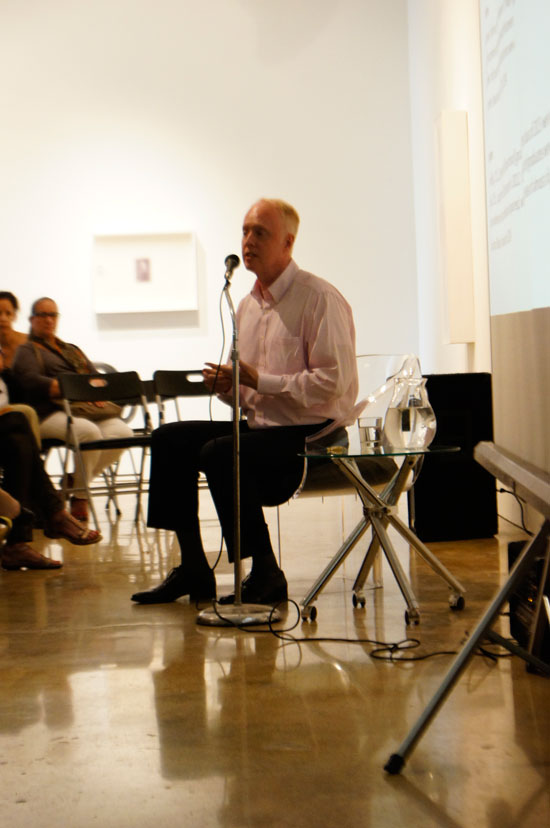New approaches to selling art in the digital age are still taking shape. So says author and New York dealer Ed Winkleman, who discussed current and evolving strategies for dealers to survive and thrive in today's swiftly changing art market at a gallery in Miami's Wynwood Arts District on April 25, 2015.
Winkleman's lecture at Emerson Dorsch gallery was the first in a series planned by the Miami Art Dealers Association (MADA), the non-profit organization established in 2009 to promote professional business practices among Miami art dealers and to present member dealers as responsible, credible professionals to both the art community and the public at large.
.

At Ed Winkleman's lecture at Emerson Dorsch gallery.
.
"Oddly enough," said MADA president Mali Parkerson, "there are still some people in Miami who don't know where Wynwood is. We have to reach out and make galleries less intimidating."
The lecture series was developed by art dealer Mindy Solomon, in charge of MADA membership and marketing, as an educational service for members and the public. "As a former art teacher," she said, "I want to have programs to educate galleries regarding what's happening in the marketplace now and how the Internet affects our business."
Plans for future programs, according to MADA vice-president Miguel Fernandez of TUB Gallery, include a week-long festival in October during which Miami galleries will present talks and programs tied to the beginning of Miami's pre-Art Basel season. "We want to provide a platform for intellectual discourse," he said.
While there was much discussion on the night of Winkleman’s talk about how the Internet is perhaps irrevocably altering the business of selling art, some questions from the audience concerned strategies for dealing with an age-old art biz conundrum: poaching. That is, how to prevent one gallery from stealing another gallery's artist, especially after the artist's work has suddenly become much in demand.
.

Ed Winkleman speaking at Emerson Dorsch gallery.
.
One approach suggested by Winkleman is to take a proactive stance to blunt the effects of poaching. Dealers should put their money where their mouth is and buy the art. That way, when a mega-gallery jacks up a poached artist's prices by multiple zeros, they can't complain.
Tapped as the first speaker in the "MADA Talks" series, Winkleman is the author of How to Start and Run a Commercial Art Gallery, co-founder of Moving Image art fair, co-owner of Winkleman Gallery in New York and at work on another book tentatively titled Selling Contemporary Art: How to Navigate the Evolving Market.
"I often turn to his book when I'm unsure about what to do. He's level-headed and clear," said MADA member Tyler Emerson-Dorsch as Winkleman was preparing to speak at the gallery she runs with Brook Dorsch. To an audience numbering around 60 and at times standing room only, Winkleman spoke for close to 90 minutes about research for his new book.
.

The crowd at Ed Winkleman's lecture at Emerson Dorsch gallery.
.
He geared his talk primarily to what he termed the mid-level gallery and the emerging artist gallery. He doled out such blunt advice as, "Your overhead does not go on holiday," even when suffocatingly slow days of August roll around in Miami and some collectors head for Ibiza.
He was also frank about how appearances can distort the industry, from emerging galleries to mega-galleries. "In this business,” he said, “perceptions about how well you are doing affect how well you are doing." Regarding the up-and-down vagaries of an artist's career, he said, "To be honest, I've seen a lot of artists move to another gallery to make it look like something is happening."
.

Ed Winkleman speaking at Emerson Dorsch gallery.
.
It's been particularly challenging for mid-level galleries to weather changes since the art market crashed in 2008, he said. Citing 2014 reports from the Wall Street Journal and the American Bar Association, he noted that many doctors and lawyers, a key sector of consumers for mid-level art galleries, have not returned to their spending levels before the 2008 crash, with detrimental consequences for galleries.
He offered a variety of ways to address the post 2008-crash business climate: develop a secondary market niche;, rent part of the gallery to artists for studios; start a complementary business--such as a book store or bar connected to the gallery or art fair. He also provided tips for negotiating exhibitor fees with managers of art fairs and evaluating their cost effectiveness.
Keeping a gallery current with the evolving landscape of social media is vital to survival, Winkleman insisted, as is staying on top of what a gallery's artists post on social media. He cited the embarrassing example of a collector calling a dealer to ask about the price of a specific work he'd recently seen one of the gallery's artists post on Instagram. Since the dealer did not know not even know that the particular work existed, he had to scramble for a response.
"Transparency is coming," Winkleman warned. "You as a dealer are not going to own all the information about an artist. We are starting to see art stars rise up outside the gallery system."
_____________________
Copyright 2015 Hamptons Art Hub LLC. All rights reserved.
